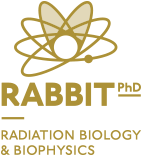Nídia Almeida

PhD Programme: Radiation Biology and Biophysics
10996
na.almeida@campus.fct.unl.pt
Research Areas
PhD Thesis: “Use of biological based nanocages for radiation protection and cellular detoxification" (2015-2019)
Advisers: Prof.ª Doutora Alice Pereira and Prof. Doutor Pedro Tavares
All#H%type proteins of the ferritin family are ferroxidases capable of sequester, oxidize and mineralize ferrous ions. The ferritin family can be divided into two types of enzymes: i) the maxi%ferritins; and ii) mini%ferritins. Maxi%ferritins arZ large spherical cages capable of oxidizing ferrous iron at different rates and store it in a mineral core form (ca. 4500 irons per molecule). These enzymes are constituted by 24 identical (for example in bacterial ferritins) or different subunits (such as in mammalian ferritins) and may contain additional cofactors for which a role is still under discussion (such as heme groups in bacterioferritins). To achieve Fe(II) oxidation, molecular oxygen and/or hydrogen peroxide is used as co% substrate, and oxidation rate is dependent of the presence of ferroxidase sites, generally binuclear carboxylate bridged centers. Mini%ferritins are smaller spherical cage proteins mainly constituted by 12 identical subunits. While capable of storing near 500 atoms per molecule, these enzymes primary task is to sequester ferrous iron while using hydrogen peroxide as co%substrate. These different sized hollow spheres can be used to incorporate different metal ions as well as other molecules. Furthermore, they can be specifically altered to produce chimeric molecules with additional functionalities. In this PhD plan we aim to produce ferritin%based functional nanocages capable of being used in radiation protection, cancer cell targeting, drug delivery systems and biosensors.



